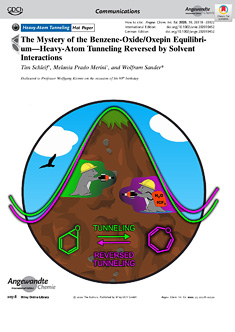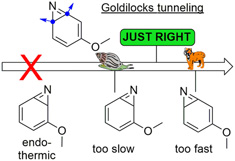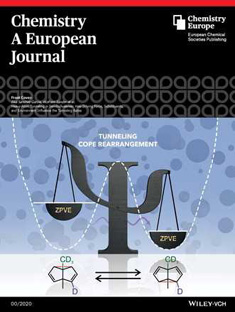Tunneling Reactions
Tunneling by solvent interactions

The Mystery of the Benzene-Oxide/Oxepin Equilibrium-Heavy-Atom Tunneling Reversed by Solvent Interactions
T. Schleif, M. Prado Merini, W. Sander, Angew. Chem. Int. Ed. 59 (2020), 20318-20322.
(Cover picture by Carla Prado Merini)
The equilibrium between benzene oxide (1) and oxepin (2) is of large importance for understanding the degradation of benzene in biological systems and in the troposphere. Our studies reveal that at cryogenic temperatures, this equilibration is governed by rare heavy-atom tunneling. In solid argon at 3 K, 1 rearranges to 2 via tunneling with a rate constant of approximately 5.3×10-5 s-1. Thus, in a nonpolar environment, 2 is slightly more stable than 1, in agreement with calculations at the CCSD(T) level of theory. However, if the argon is doped with 1 % of H2O or CF3I as typical hydrogen or halogen bond donors, respectively, weak complexes of 1 and 2 are formed, and now 2 is tunneling back to form 1. Thus, by forming non-covalent complexes, 1 becomes slightly more stable than 2 and the direction of the heavy-atom tunneling is reversed.
Read the Paper in Angew. Chem. Int. Ed.
Heavy-Atom Tunneling in Semibulvalenes
Heavy-Atom Tunneling in Semibullvalenes: How Driving Force, Substituents, and Environment Influence the Tunneling Rates
T. Schleif, J. Tatchen, J. f. Rowen, F. Beyer, E. Sanchez-Garcia, W. Sander, Chem. Eur. J. 26 (2020), Ahead of Print
Invited for the cover of this issue are the groups of Elsa Sanchez-Garcia and Wolfram Sander at the Universität Duisburg-Essen and the Ruhr-Universität Bochum. The image depicts the ideas skillfully visualized by Markus Henkel on the shift in equilibrium induced by isotopic labelling.
Read the Paper in Chem. Eur. J.
Heavy-Atom Tunneling Rearrangement

Conformer-Specific Heavy-Atom Tunneling in the Rearrangement of
Benzazirines to Ketenimines
T. Schleif, J. Mieres-Perez, St. Henkel, E. Mendez-Vega, H. Inui, R. J. McMahon, W. Sander, J. Org. Chem. 84 (2019), 16013-16018.
5-Methoxy-2H-benzazirine was prepared via irradiation of the corresponding phenyl azide, isolated in an argon matrix at cryogenic temperatures. It undergoes ring expansion to the corresponding ketenimine in the dark at T < 30 K despite a calculated activation barrier of 4.9 kcal mol–1 [B3LYP/6-311++G(d,p)]. Since this rearrangement proceeds with a rate constant in the order of 10–4 s–1, exhibiting only a shallow temperature dependence, the results are interpreted in terms of heavy-atom tunneling. Of the four isomeric benzazirines resulting from the initial photolysis, only one can be observed to rearrange; this conformer specificity is explained by the other potentially observable rearrangements being either too fast or too slow to be detected due to the differences in heights and widths of their respective activation barriers.
Tunneling Rearrangement of 1-Azulenylcarbene
1-Azulenylcarbene was synthesized by photolysis of 1-azulenyldiazomethane in argon or neon matrices at 3–10 K. The highly polar singlet carbene is only metastable and undergoes a tunneling rearrangement to 8-methylene-bicyclo[5.3.0]deca-1,3,5,6,9-pentaene. After substitution of the 4 and 8 positions with deuterium, the rearrangement is completely inhibited. This indicates a very large kinetic isotope effect, as expected for a tunneling reaction.

S. Henkel, Y. Huynh, P. Neuhaus, M. Winkler, W. Sander, J. Am. Chem. Soc. 134 (2012), 13204-13207.


